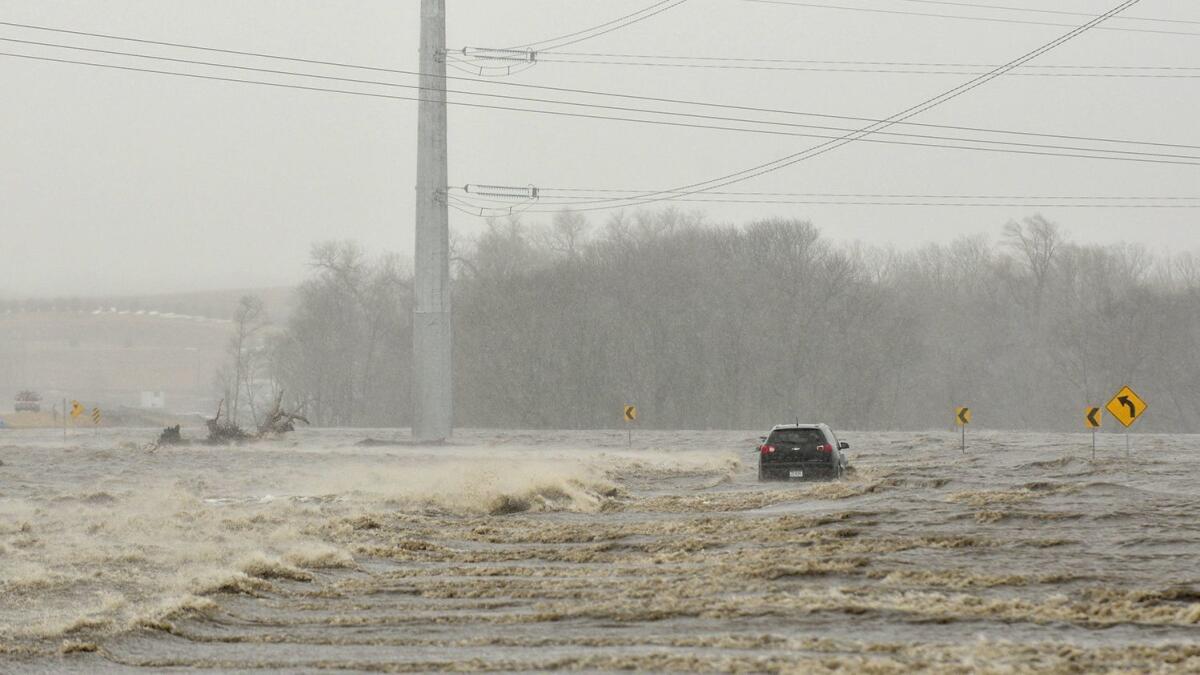Emergencies declared across Midwest amid ‘historic’ flooding

- Share via
Authorities in the Midwest declared states of emergency amid what they called “historic” flooding, which forecasters warned would stretch through the weekend.
The flooding shut down roads, forced scores of people to evacuate their homes and cut off access to some towns and cities. In Nebraska, which has seen some of the most significant flooding, Gov. Pete Ricketts said the impacts of the “devastating flooding ... could last for quite some time.”
Even the forecasters were not immune: The National Weather Service in Omaha reported Friday that it had to evacuate its offices because of rising waters.
Forecasters said Saturday that at least five states were still facing the flood threat. “Major and historical river flooding will continue this weekend focused across Iowa, southern Minnesota and Wisconsin, eastern Nebraska and southeast South Dakota,” the National Weather Service reported.
The surging water was fueled by a powerful winter storm — a “bomb cyclone” — that battered the region with strong winds and heavy rainfall. The resulting flooding was particularly intense because the heavy rain fell on snow that had not melted yet, said Brian Barjenbruch, the science and operations officer for the weather service in Omaha.
“And the ground was completely frozen,” he said in an interview. “It’s almost like all of this rain was falling, melting snow and every last drop had to run off.”
Barjenbruch said the results have been incredibly damaging in parts of eastern Nebraska and western Iowa.
“It is some of the worst flooding that we’ve seen in many years,” Barjenbruch said of those areas. “In some locations it’s the worst flooding on record on many of these river gauges.”
Along with Ricketts, governors in Wisconsin and South Dakota declared emergencies, while Iowa’s governor issued a wave of disaster proclamations. South Dakota Gov. Kristi Noem said she signed an emergency declaration to free up more state money for people affected by the storm and the flooding.
“The storms this week have been extremely difficult for many of our communities,” Noem said in a statement. “This has been a statewide emergency with people impacted by heavy snow, high winds, rain, and freezing rain.”
In his emergency declaration, Wisconsin Gov. Tony Evers said the storm had “moved across the entire state of Wisconsin” between Wednesday and Friday. In its wake, he said, water was “rising swiftly.”
“The warm temperatures and rain the last few days have caused much of the heavy snowpack and ice to melt resulting in flooding, ice jams, and rivers and creeks to rise,” Evers said in a statement.
In Nebraska, scores of residents rushed into shelters while state troopers fanned out for water rescues, officials said.
“Nebraska has experienced historic flooding and extreme weather in nearly every region of the state,” Ricketts posted in a statement on Twitter. He issued a disaster declaration on Tuesday.
President Trump on Friday afternoon said he had spoken to Ricketts about the situation.
“The people of Nebraska & across the Midwest, especially the Farmers & Ranchers, are feeling the impacts from severe weather,” he tweeted.
The flooding had closed off main routes through parts of the region, said Jennifer Arthur, 44, a bartender at Jack’s Place in Omaha.
“You go a couple of miles ... you can’t make it very far,” Arthur said. “You just can’t get into town.”
Arthur said that Jack’s had additional customers because the water had closed some other bars and restaurants — and that the flooding was the main topic of conversation.
“There’s a lot of people impacted that had to get out real fast,” she said. “A lot of people are going to friends’ houses, hotels.”
Officials said the flooding has caused severe damage in some areas, tearing apart pieces of roadways and bridges.
“The power of water is really quite impressive,” said Barjenbruch. “When that water moves out of the channel it is normally in, it interacts with roads, bridges in ways it doesn’t normally. When that happens ... we have roads fail, bridges fail, we’ve even had dams fail in far northeastern Nebraska.”
Barjenbruch added: “The power of water should never be underestimated.”
Forecasters have also warned that, because of significant precipitation during winter and because of what the Washington Post’s Capital Weather Gang called “an active spring storm track through the nation’s midsection,” this flooding in the Midwest may only be the start of a painful flood season.
Berman writes for the Washington Post.
More to Read
Sign up for Essential California
The most important California stories and recommendations in your inbox every morning.
You may occasionally receive promotional content from the Los Angeles Times.













